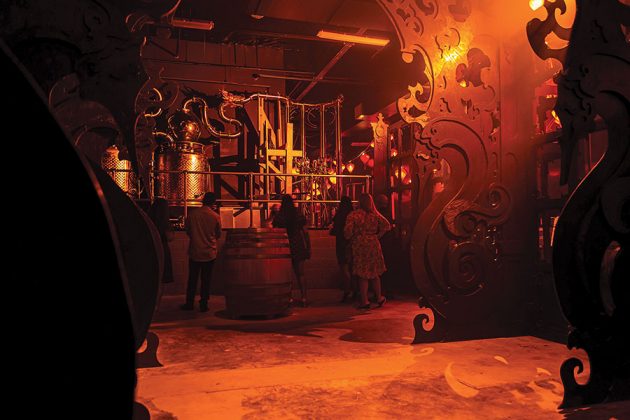Do you know your “4 P’s” for distillery tours? Flagler College Hospitality and Tourism professor Zachary Cole shares the state of the art in the newest form of distillery traffic-creation.
Distillers big and small stand to gain from increased foot, eyeball, and taste bud traffic. Understanding what people are looking for in a distillery experience is key to driving door sales and generating solid word-of-mouth marketing. Equally important is unraveling the equation of getting people in the door to begin with — experiencing your product (and process) efficiently and effectively without taking away from production and packaging. Who might these potential visitors be and what exactly are they looking for when they visit?
An ever-increasing travel motivation has been the desire to experience local products as a way to tap into an authentic experience. In the past these food and beverage tourists were largely older and wealthier, nowadays over half of all travelers at least partially base their destination decisions on available food and drink. And while local is great, whether with local ingredients or locals’ craftmanship, it is simply not enough in a landscape of ‘local’. In this world of (claimed) authenticity and craft it is the stories — your story, the story of place and space, stories around your products — that cut through and connect travel motivations to visitation and ideally, purchase.
Any good story or storyteller first takes into consideration the audience – i.e. who are we telling the story to? In the current post-COVID tourism rebound people are driving to their destinations at a higher rate and seeking activities that are individual or small-group in areas of dispersed development — trends that are ideally suited to a majority of distilleries and which are predicted to continue for the longer term. As such, an immediate consideration of the potential for tourist visitation should be assessment of proximity to established tourism destinations or travel corridors — where are people coming from and where are they going? The next question is then one of understanding the dynamics of potential visitors’ travel behavior — are they coming for the day, staying overnight, or just driving through? While much of this information can be revealed through anecdotal consideration and general understanding of the area in which you operate, more directed information (and often hard data) is readily available through tourism organizations at various scales. Examples at the local level include chambers of commerce, destination marketing organizations, visitor and convention bureaus, or offices of economic development. Additionally, each state now has a state-level tourism office while many regional agencies have also been developed, some of which cross state lines while others represent unique regions within individual states. At minimum these are worth connecting to and exploring available resources — membership is often nominal in cost and highly beneficial for access to data and also general marketing representation.
After we get people in the door to hear our story, how then do we tell it in the most effective way? Storytelling can be easily outlined through 4 Ps — people, place, plot, and purpose — and I like to approach them in reverse order. When cultivating your distillery/product story, specifically how it relates to established brand image, these can serve as an outline in which to get started: Purpose — creating a deeper understanding of the product, process, and ultimately the brand; Plot — bringing customers into the process to create brand buy-in; Place — explaining how but more importantly why your product/brand represents “local”; People — generating an immersive experience that taps into all five senses. One of the most effective ways to address all the aforementioned aspects of storytelling is through tours and tastings. While the dynamics and viability of doing this is different at every distillery, there are some universal considerations worth noting. An affective baseline in considering creating a tour/tasting experience or improving on an existing one is the application of designing for the five senses — how does the tour/tasting experience engage sound, touch, sight, smell, and taste? In this age of personalization, creating a tour/tasting experience that is internally customizable is increasingly desirable. For instance, operation of self-guided tours that utilizes modern technology (audio and visual) for storytelling/brand engagement is increasingly common and can lower the human resource burden and allows for the personalized engagement of the five senses that most visitor seek. Here are some additional ideas for generating on-site experiences and leveraging that exposure for purchase conversion and word-of-mouth marketing amongst tourists:
Make it shareable — provide photo ops, make it pretty! Consumers are increasingly weary of brand-generated content, with evidence to suggest people are starting to turn back to recommendations from friends and family — albeit often communicated via social media.
Hands-on/VIP experiences — travel motivation/satisfaction is increasingly based on experience — food and drink affect all five human senses making them one of the most influential experiences. Leveraging this is critical to purchase conversion/brand engagement and can be done relatively simply if considered in the context of the tour/tasting experience offered. In the case of creating VIP experiences (barrel buying, food pairings, create your own gin) it can serve as an additional profit generator as well.
Events and collaboration — find ways to offer additional amenities to your customers and more efficiently utilize your space and resources. To the former, collaborate with food trucks/pop-up restaurants — all travelers eat and drink so why not combine your unique spirit offerings with local food crafters. To the latter, consider utilizing your space for off-hour small events — think families, reunions, wedding parties, etc.
Travel is growing, with domestic travel increasing at a record pace in the US and elsewhere as people seek regional destinations that are embedded with local and authentic experiences. Local and regional distilleries and their products inherently fit these motivations and when considered carefully, travelers can be a potentially effective market to tap into, growing brand engagement and driving purchase conversion at a low overhead relative to other marketing efforts. Spirits are passion products, for those who craft them and those who consume them. Research shows that travelers are saving money to splurge on craft food and drink when traveling, a trend that transcends socioeconomic status and geography.










